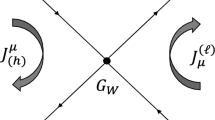Abstract
In this note, I briefly review Lyre’s (2008) analysis and interpretation of the Higgs mechanism. Contrary to Lyre, I maintain that, on the proper understanding of the term, the Higgs mechanism refers to a physical process in the course of which gauge bosons acquire a mass. Since also Lyre’s worries about imaginary masses can be dismissed, a realistic interpretation of the Higgs mechanism seems viable. While it may remain an open empirical question whether the Higgs mechanism did actually occur in the early history of the universe and what the details of the mechanism are, I claim that the term can certainly refer to a physical process.
Similar content being viewed by others
Notes
Remember m 2 < 0. Therefore, −2m 2 > 0 and \(\sqrt{-2m^2}\) positive and real.
For some purposes, this statement may be over-simplified. The relation m A = qv (see Table 1) shows how the mass of the gauge boson depends on the strength of the coupling q of the scalar field to the gauge field. The second row of Table 1 shows how, in the broken phase, the introduction of a gauge field and the requirement of a local symmetry, instead of only a global one, leads to the disappearance of the (massless) Goldstone boson π. These observations are emphasized in Higgs (1964) and Anderson (1963), for instance. Accordingly, in a more complete characterization, the Higgs mechanism should be regarded as the combination of the two processes of coupling the scalar field to the gauge field (going from left to right in the second row of Table 1) and the transition from the symmetric to the broken phase of a local symmetry (going from top to bottom in the second column of Table 1).
To my knowledge, the metaphor goes back to (Coleman 1985, 123).
See also (Weinberg 1996, 296), for instance.
Textbooks are often not completely clear about what they call the “Higgs mechanism”. However, this has mainly to do with the fact that a complete characterization of the mechanism should also include the transition from a system with zero coupling of the scalar and the gauge field to a system with non-zero coupling, see footnote 2. The clearest expositions I have found are (Peskin and Schroeder 1995, chapter 20), (Ryder 1996, chapter 8) and (Weinberg 1996, chapter 21), which, as far as I can tell, never share Lyre’s understanding of the “Higgs mechanism”.
References
Anderson, P. W. (1963). Plasmons, gauge invariance, and mass. Physical Review, 130(1), 439–442.
Coleman, S. (1985). Aspects of symmetry. Cambridge: Cambridge University Press.
Higgs, P. W. (1964). Broken symmetries and the masses of gauge bosons. Physical Review Letters, 13(16), 508–509.
Linde, A. (1990). Particle physics and inflationary cosmology. Switzerland: Harwood Academic Publishers.
Lyre, H. (2008). Does the Higgs mechanism exist? International Studies in the Philosophy of Science, 22(2), 119–133.
Peskin, M. E., & Schroeder, D. V. (1995). An introduction to quantum field theory. Reading: Addison-Wesley.
Ryder, L. H. (1996). Quantum field theory (2nd ed.). Cambridge: Cambridge University Press.
Weinberg, S. (1974). Gauge and global symmetries at high temperature. Physical Review D, 9, 3357–3378.
Weinberg, S. (1996). The quantum theory of fields, volume II: Modern applications. Cambridge: Cambridge University Press.
Wiese, U.-J. (2010). The standard model of particle physics. Lecture notes. Institute for Theoretical Physics, University of Bern. URL last accessed December 8, 2011. http://www.wiese.itp.unibe.ch/lectures/standard.pdf.
Acknowledgments
I thank Anthony Duncan, Holger Lyre, and Uwe-Jens Wiese for valuable discussions, and two anonymous referees as well as the editors Meinard Kuhlmann and Wolfgang Pietsch for their helpful comments. I also gratefully acknowledge the funding provided by the University of Pittsburgh’s Center for Philosophy of Science for the postdoctoral fellowship during which I revised and completed this article.
Author information
Authors and Affiliations
Corresponding author
Rights and permissions
About this article
Cite this article
Wüthrich, A. Eating Goldstone Bosons in a Phase Transition: A Critical Review of Lyre’s Analysis of the Higgs Mechanism. J Gen Philos Sci 43, 281–287 (2012). https://doi.org/10.1007/s10838-012-9201-5
Published:
Issue Date:
DOI: https://doi.org/10.1007/s10838-012-9201-5




